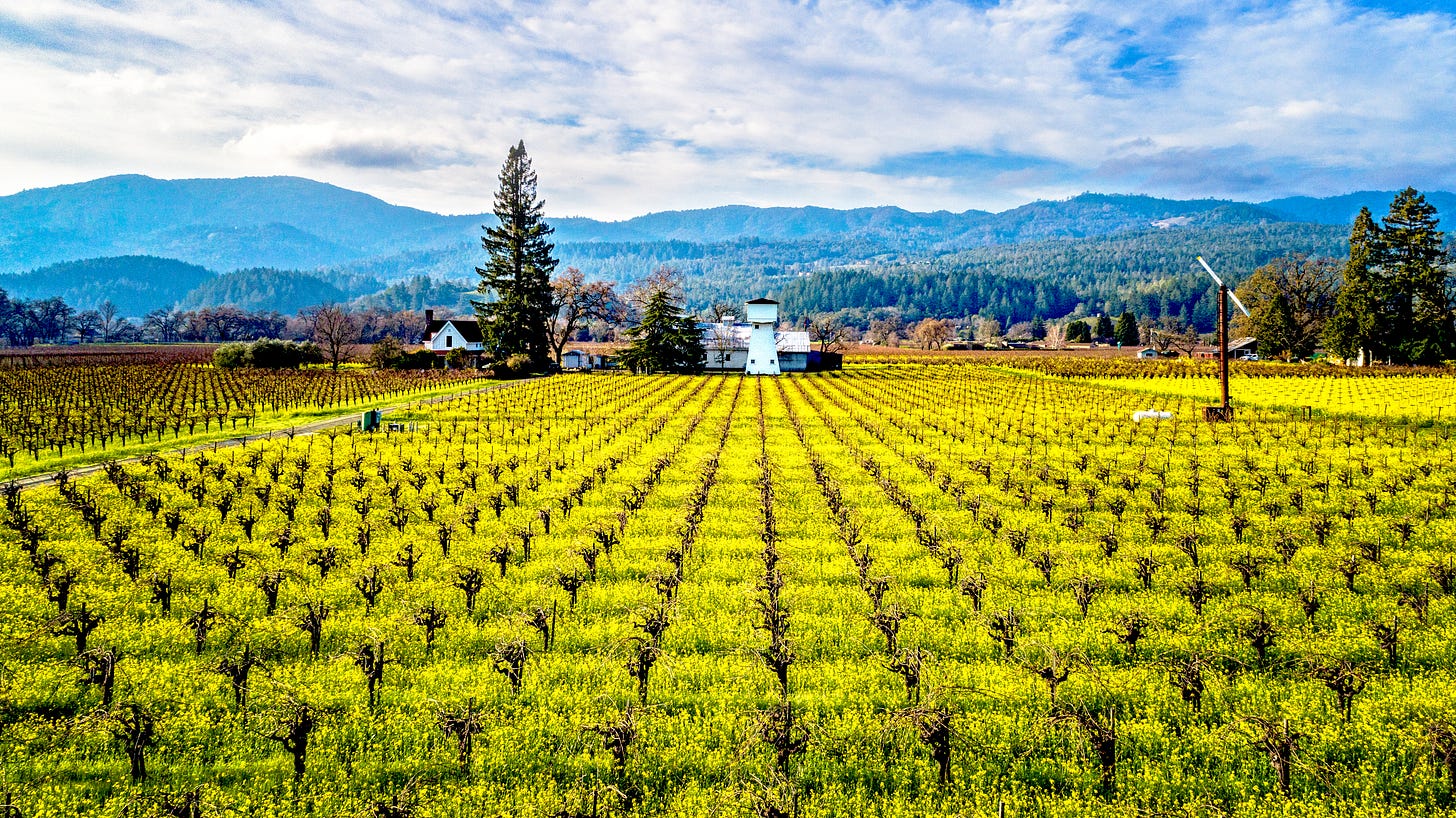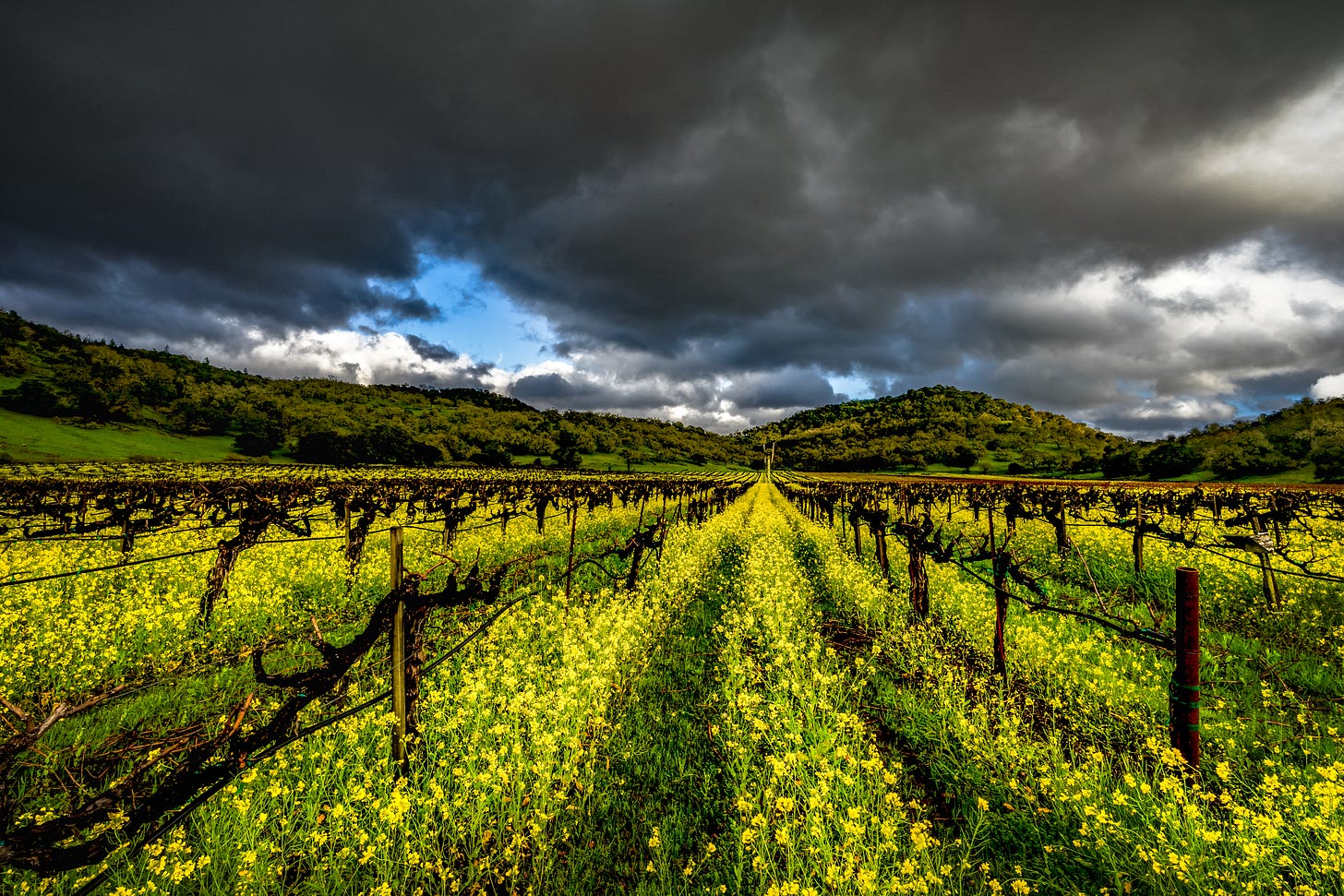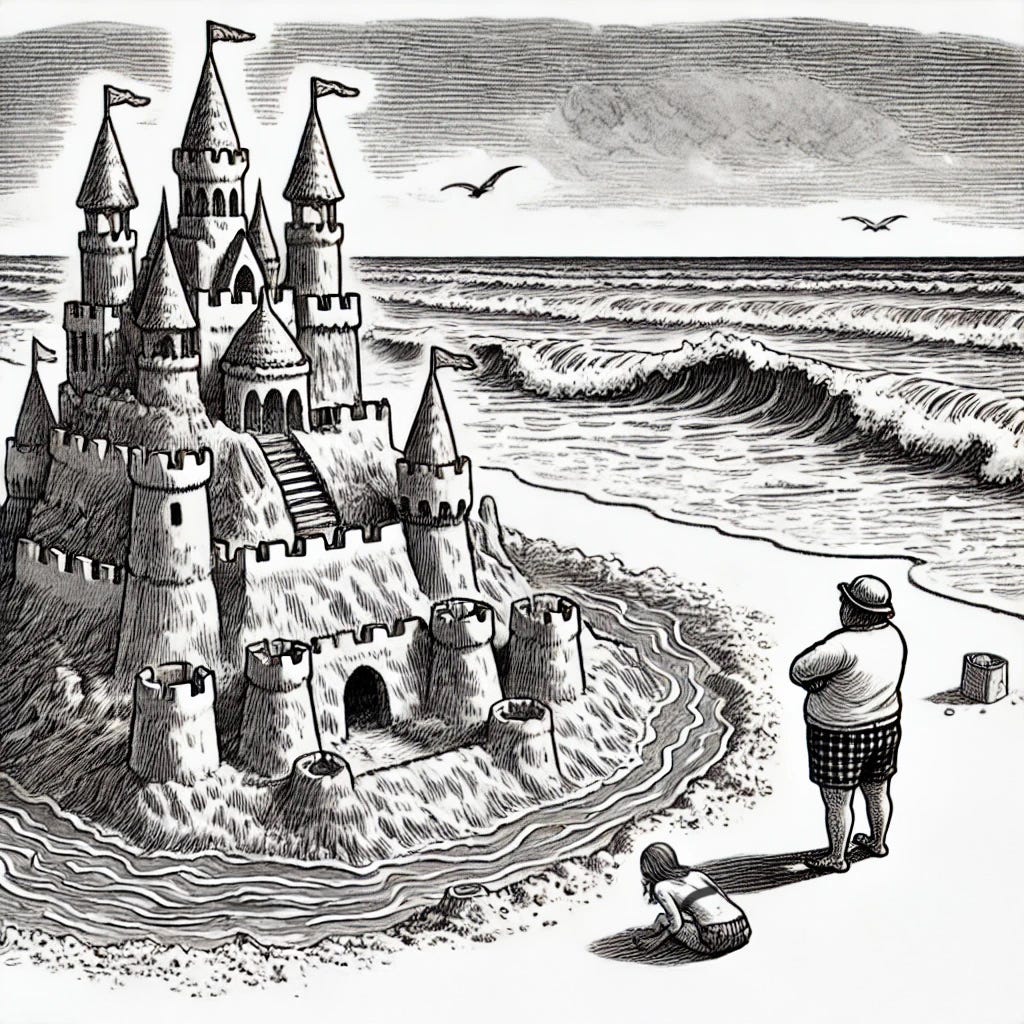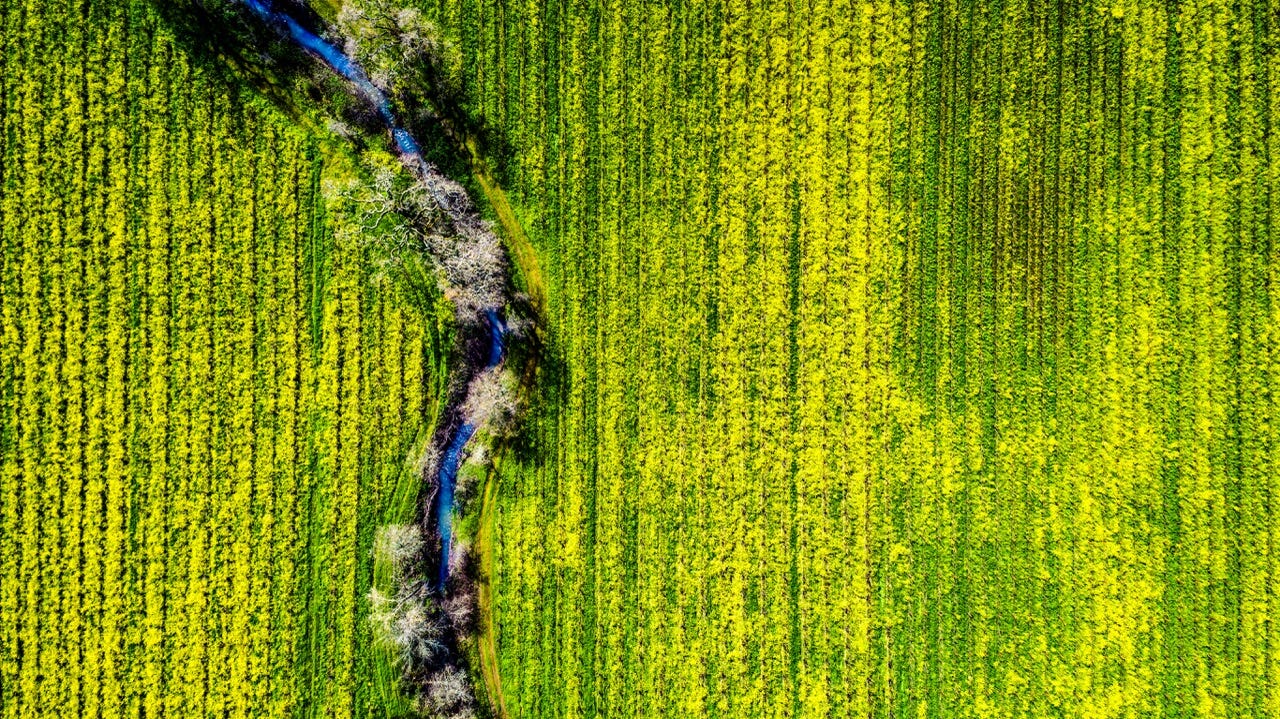Support Napa Valley Features – Become a Paid Subscriber Today
If you’re reading this, you care about independent, locally owned, ad-free journalism — reporting that puts our region’s stories first, not corporate interests or clickbait.
As local newsrooms are increasingly bought by billionaires, scaled back or absorbed into media conglomerates, communities lose original reporting and are left with more syndicated content. Your support keeps quality regional journalism alive.
Join a community that values in-depth, independent reporting. Become a paid subscriber today — and if you already are, thank you. Help us grow by liking, commenting and sharing our work.
Mustard Time in Napa
By Georgeanne Brennan
NAPA VALLEY, Calif. — Every spring the Napa Valley landscape turns bright yellow with wild mustard, and every spring someone asks me, “Is it edible?” The answer is yes. It’s part of the Brassicaceae family, Sinapis arvensis, the same family that includes mustard greens, and it has a similar flavor, though with smaller leaves and thinner stalks. You can gather the wild mustard and treat it to long cooking to tenderize and mellow it or chop it and add it to stir-frys. Please note that the warmer the weather and the more mature the mustard, the more pungent it is. I like to use the young, tender leaves and the flowers in spring salads. The flowers add a bright spot of color and a lacy texture, and the leaves give the salad a pleasant tang.
Another fascinating way to use the wild mustard is to wait until the seed pods form and dry slightly but before they shatter. Strip the seeds from the pods, and when you have a cup or so, you can make your own mustard, grinding the seeds first.
From Roman times, mustard was planted between rows of vineyards, and the pungent paste was made using verjus , the juice of unripe grapes, or later in the season, grape must, the byproduct of winemaking.
Commercially, the seeds used to make mustard have been selected over the years for yield and for plants that hold the seeds in the pods and don’t shatter. There are three main kinds of mustard seed produced: black (Brassica nigra), brown (B. juncea) and white (B. hirta/Sinapis alba). Napa’s wild mustard tends to have small, black seeds. Canada, Nepal and Russia are the world’s largest producers of mustard seeds, but they are also grown in the United States, France, Ukraine and other parts of the world.
Mustard has been around for thousands of years, notably in Egypt and other parts of the Mediterranean, as well as China, both as a condiment and a medicinal. Remember reading about mustard plasters for chest colds? From Roman times, mustard was planted between rows of vineyards, and the pungent paste was made using verjus , the juice of unripe grapes, or later in the season, grape must, the byproduct of winemaking. Today’s mustards made with must are labeled purple mustard or Moutarde de Violette (not made with violet flowers as I once romantically thought).
Different mustards are made with different seeds. French’s neon-yellow mustard is made with white mustard seeds, and the bright color comes from the addition of turmeric. My everyday go-to mustard is Dijon, made with black and brown seeds, sometimes flavored with tarragon, and, when I can get it, Moutarde de Bourgogne which is made in the traditional way with white wine from Burgundy and seeds grown in Burgundy. Chinese hot mustard is made with brown seeds. The grainy, stone-ground mustards are usually made with brown seeds, too, but different mustards might include mustard powder, lemon or orange zest, garlic, honey, water, vinegar and even flour. Bulk mustard seeds and ground powder are readily available at spice suppliers. I encourage you to have a go at making your own, or at least, to explore the various types available.
If gathering pods of Napa’s wild mustard seems tedious, try making your own with purchased cultivated mustard seeds or mustard powder. It is surprisingly easy and quite fun.
Here’s my recipe for Green Herb Mustard, adapted from my book, “The Glass Pantry.”
GREEN HERB MUSTARD
Start to finish: 1 hour and 15 minutes
Servings: 1 pint
½ teaspoon sea salt
1 teaspoon granulated sugar
½ teaspoon white pepper
1 cup white vinegar
1 cup water
1 cup dry mustard
½ cup mixed chopped fresh tarragon and chives
Combine the salt, sugar, pepper, vinegar and water in a saucepan over medium high heat and bring to a boil. Slowly stir in the dry mustard. Reduce the heat to low and simmer until the mixture thickens to a creamy consistency, stirring from time to time, about 1 hour.
Stir in the herbs and simmer for 1 to 2 minutes longer. Remove from the heat and spoon into hot, dry, sterilized jars with lids. Cover tightly and let cool. When cool, store in the refrigerator. Wait 3 or 4 days before using to allow the flavors to mellow and blend. The mustard will keep up to 3 months.
POULET A LA MOUTARDE
This is a classic recipe from Dijon, Chicken with Mustard, calling, of course, for Dijon mustard. Just add a few boiled potatoes to accompany it, a green salad and perhaps a bottle of pinot noir. e
Start to finish: 1 hour
Servings: 4 to 6
½ cup all-purpose flour
2 ½ teaspoons sea salt, divided
1 teaspoon sweet paprika
1 whole chicken, cut into 6-8 pieces
2 ½ tablespoons butter, divided
1 tablespoon extra-virgin olive oil
½ teaspoon freshly ground black pepper
1 medium onion, chopped
3 ½ tablespoons Dijon mustard, divided
½ cup dry white wine
½ cup chicken broth
½ cup water
2 sprigs fresh thyme
3 tablespoons crème fraiche
Lay out a large sheet of aluminum foil. Scatter with the flour, 1 teaspoon of the salt and paprika and mix lightly with a fork. Add the chicken and turn several times to coat well with the flour mixture. Mix one tablespoon of the flour mixture with 1 tablespoon of the butter and press into a ball. Set it aside.
In a Dutch oven or large sauté pan over medium-high heat, warm half the butter and oil. When it is hot add the chicken pieces, but don’t crowd them. If necessary, work in two batches. Cook until the chicken is brown and crispy, 3 or 4 minutes. Turn and brown the other side, another 3 or 4 minutes. With tongs, remove to a bowl and sprinkle with the pepper.
Reduce the heat to medium, add the onion and sauté until translucent, adding more oil or butter if needed, about 3 minutes. Using a slotted spoon, remove the onions to the bowl with the chicken.
Add 1 tablespoon of the mustard to the pot and stir for 1 to 2 minutes, letting the mustard cook slightly. Increase the heat to high, and add half the wine, stirring to dislodge any clinging bits. Add the rest of the wine and continue to cook, decreasing the wine by half. Add the broth and the water. Stir well.
Return the chicken and onions to the pot, add the thyme and cover. Reduce the heat to low and simmer until all the chicken pieces are easily pierced with the tines of fork, about 30 to 35 minutes.
With tongs, remove the chicken to a warmed platter and lightly cover with foil.
Stir the remaining mustard into the pot along with the crème fraiche to make a smooth sauce. Taste and adjust the salt and pepper if needed. Add the reserved butter and seasoned flour ball, and stir, cooking until the sauce has thickened to the consistency of thin cream, a minute or 2.
Spoon the hot mustard sauce over the chicken. Serve immediately.
Georgeanne Brennan is an award-winning cookbook author who divides her time between her farm in Northern California and a home in Provence. Learn more about her at her website.
Today’s Polls
Explore These Related Articles:
Browse All Napa Valley Features Stories
Poem of the Day
Gifts of the Land
By Virgil, from “Georgics”(Book I, lines 55–59), c. 29 BCE
"Here, wheat, there, vines, flourish more happily:
trees elsewhere, and grasses, shoot up unasked for.
See how Tmolus sends us saffron fragrance,
India, ivory, the gentle Sabeans, their incense,
while the naked Chalybes send iron, Pontus rank
beaver-oil, Epirus the glories of her mares from Elis."
About the Author: Virgil (Publius Vergilius Maro, 70–19 BCE) was one of ancient Rome’s greatest poets, best known for “The Aeneid,” “Eclogues” and “Georgics.” His works shaped Western literature for centuries, influencing poets from Dante to T.S. Eliot and the 20th-century writer Ursula K. Le Guin, who drew from Virgil’s themes of exile, duty and the natural world in her own poetry and speculative fiction.
The “Georgics,” written around 29 BCE, is a didactic poem in four books celebrating agriculture and the relationship between humans and nature. Commissioned by Augustus, it was both a practical guide and a meditation on the land’s beauty and challenges. Virgil emphasizes the toil and rewards of farming, drawing parallels between agricultural labor and the discipline required to build a stable society.
The excerpt featured here highlights the richness of the land, where different regions contribute unique agricultural and natural products — just as Napa Valley’s vineyards and wild mustard fields create a distinct and seasonal landscape. The reference to Tmolus, an ancient mountain in Lydia known for its saffron, connects the poem to long-standing agricultural traditions and the global nature of trade and cultivation.
Virgil’s influence extends far beyond agriculture. His most famous work, “The Aeneid,” shaped epic storytelling for centuries. In it, he wrote, "Forsan et haec olim meminisse iuvabit" — “Perhaps one day it will bring pleasure to remember even this" — a line that speaks to resilience in the face of hardship, much like the enduring cycle of the land itself.
Are you a poet, or do you have a favorite piece of verse you'd like to share? Napa Valley Features invites you to submit your poems for consideration in this series. Email your submissions to napavalleyfeatures@gmail.com with the subject line: "Poem of the Day Submission." Selected poets will receive a one-year paid subscription to Napa Valley Features (a $60 value). We can’t wait to hear from you.
Caption Contest
Pick your favorite caption or add your own in the comments below.
Possible Captions:
"We get it. You read Virgil."
"Every spring with this guy."
"I knew I should have hung out with the owls."
"Is this why the other rabbits left?"
"That’s great, but I’m still eating the flowers."
Last week’s contest results
In “Sunday E-dition: Ambulances for Ukraine,” the winning caption was, "Are you sure the moat is big enough?,” with 75% of the votes.
"Are you sure the moat is big enough?"
"This is why I don’t go into real estate with you."
"On the plus side, it’s a very exclusive neighborhood."
"The key is to finish fast, before the tide comes in."
"Is it too premature to start gathering pairs of animals?"
Last Week
Last week, Tim Carl explored the growing instability in wine investment in “Under the Hood: Has the Fine Wine Investment Boom Gone Bust?” The article detailed the sharp decline of the Liv-ex California 50 index, Duckhorn’s privatization, and speculation about Constellation Brands’ potential exit from the wine sector. It also examined the struggles of publicly traded wine companies, shifting consumer preferences and broader economic pressures affecting the market. The analysis suggested that fine-wine investments may face a prolonged correction rather than a quick rebound.
Dan Berger examined the threat to wine research funding in "Funding for Wine Research Is at Risk." In February, the U.S. government abruptly fired eight Agricultural Research Service employees conducting vital studies on grape breeding, vineyard pests and smoke exposure, only to rescind the decision days later. Berger highlighted the importance of scientific research in winemaking, noting that countries like France and Australia invest heavily in advancements. Industry leaders warned that cuts to research programs could hinder innovation, particularly as climate change threatens grape growing. The U.S. wine industry contributed $276 billion to the economy in 2022, underscoring the stakes of potential funding reductions.
Sasha Paulsen detailed Sonoma’s effort to support Ukraine in "Ambulances for Ukraine." The Sonoma-Kaniv Committee partnered with Chicago-based nonprofit Ambulances for Ukraine to send a retired ambulance stocked with medical supplies to Kyiv General Hospital. The initiative, sparked by a Sonoma Valley Fire Department vehicle retirement, drew community donations and support. The ambulance, marked with messages of encouragement, reached Ukraine in November, and in February, Sonoma received a letter of gratitude from Kaniv’s mayor. Paulsen reflected on the power of grassroots action, contrasting it with political turmoil in Washington.
Last week, Chris Benz highlighted the recent Napa Climate Summit and Job Fair in "Climate Summit and Job Fair to Give Napa Youth a Leg Up." Held on March 12 at Napa Valley College, the event introduced high school students and young adults to climate-focused careers. Keynote speaker Tyla Brown of MCE shared her journey into environmental work, while a panel of local leaders discussed climate actions. The Job Fair featured exhibitors offering internships, apprenticeships and job opportunities in renewable energy and green construction. Organizers emphasized the growing demand for skilled workers in climate-related fields.
Penny Pawl shared tips for growing potatoes in "Now Is the Time for Planting Spring Spuds." She explained the history of potatoes, their susceptibility to fungal blight, and the importance of crop rotation. Pawl provided guidance on selecting seed potatoes, preparing soil, and planting techniques, including container gardening for small spaces. She also advised on fertilizing, watering and protecting plants from frost. Pawl encouraged gardeners to attend upcoming UC Master Gardener workshops for hands-on learning.
















